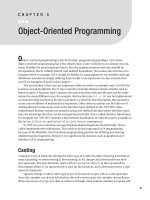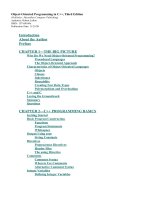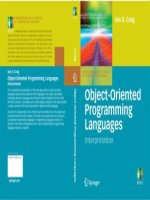Lecture Object oriented programming - Lecture No 31
Bạn đang xem bản rút gọn của tài liệu. Xem và tải ngay bản đầy đủ của tài liệu tại đây (117.44 KB, 26 trang )
CSC241: Object Oriented Programming
Lecture No 31
1
Previous Lecture
•
A linked list data storage class
data ptr
data ptr
data ptr
data ptr
ptr
template
struct Node
{
TYPE data;
Node* next;
};
template<class TYPE>
class linklist {
private:
Node<TYPE>* first;
public:
void additem(TYPE
d);
void del();
void display();
2
Today’s Lecture
•
Stream and classes
•
Input and Output stream
•
iostream class
•
ios class
–
Formatting Flags
–
Error-Status Bits
–
File operations
3
Stream Classes
•
•
A stream is a flow of data (sequences of bytes)
In C++ a stream is represented by an object of a
particular class
–
•
For example, the cin and cout stream objects
Different streams are used to represent different
kinds of data flow
–
For example, the ifstream class represents data flow
from input disk files
4
Advantages of Streams
•
•
Simplicity
–
E.g. using printf and scanf function, there is a need to
specify the type of input or output i.e. %d, %f or %c
etc.
–
There are no such formatting characters in streams,
since each object already knows how to display itself
Overload existing operators and functions
–
Use exisiting operator for class in the same way as
the built-in types
5
I/O stream classes
•
•
•
It represent input and output stream
–
In input stream, the bytes flow from a device (e.g., a
keyboard) to main memory
–
In output stream, bytes flow from main memory to a
device (e.g., a display screen, a printer)
We have already use stream class
–
Extraction operator >> is a member of istream class
–
Insertion operator << is a member of ostream class
istream and ostream are derived from ios
6
cout and cin
•
•
cout object:
–
It representing the standard output stream
which is usually monitor
–
It is a predefined object of the
ostream_withassign class, which is derived
from the ostream class
cin object:
–
Represent standard input stream which is
usually key board
7
Header files
•
IOSTREAM
–
•
classes used for input and output to the video display
and keyboard are declared in header file IOSTREAM
FSTREAM
–
classes used specifically for disk file I/O are declared
in the file
8
iostream class
•
•
iostream class is derived from both istream and
ostream by multiple inheritance
Classes derived from it can be used with e.g.
disk files, that may be opened for both input and
output at the same time
9
ios class
•
•
•
It is base class of all the stream classes
It contains the majority of the features to operate
C++ streams
Three most important features are
–
Formatting flags,
–
Error-status flags,
–
File operation mode
10
Formatting Flags
•
•
•
It is a set of flag in ios class
Flags act as on/off switches that specify various
aspects of input and output format and operation
All the flags can be set using the setf() and
unsetf() ios member functions
11
ios formatting flags
12
Cont.
•
All flag are the member of ios class so they can
be access using scope resolution operator
–
•
ios::skipws
Example
float x = 18.0;
cout<< x << endl;
cout.setf(ios::showpoint);
cout<< x << endl;
cout.setf(ios::scientific);
cout<< x << endl;
Go to
program
13
ios manipulators / functions
•
•
Manipulators are formatting instructions inserted
directly into a stream
–
endl
–
setw(int)
Functions can use to set the formatting flags and
perform other tasks
–
width(w);
Go to
program
14
The istream Class
•
It is derived from ios, performs input-specific
activities, or extraction
Function
Purpose
>>
Formatted extraction for all basic (and
overloaded) types.
get(ch);
Extract one character into ch.
get(str)
Extract characters into array str, until
‘\n’.
get(str, MAX) Extract up to MAX characters into array.
15
The ostream Class
•
It handles output or insertion activities.
Function
Purpose
<<
Formatted insertion
for all basic (and overloaded) types.
Insert character ch into stream.
Flush buffer contents and insert
newline.
Insert SIZE characters from array str
into file.
put(ch)
flush()
write(str,
SIZE)
16
Predefined Stream Objects
•
cin
•
cout
•
cerr, an object of ostream_withassign,
•
–
for error messages
–
displayed output immediately, rather than being
buffered, as cout is
clog, an object of ostream_withassign,
–
for log messages
–
its output is buffered
17
Stream Errors
•
•
•
cout<<”Enter a
number”;
cin >> var;
This approach assumes that nothing will go
wrong during the I/O process
This isn’t always the case
What happens if a user enters the string “nine”
instead of the integer 9
18
Error-Status Bits
•
Stream error-status flags reports errors that
occurred in an input or output operation
Inputting Numbers
Go to
program
19
Disk File I/O with Streams
•
•
•
Disk I/O stream are
–
ifstream for input
–
fstream for both input and output
–
ofstream for output
These classes are declared in FSTREAM
header file
Objects of these classes can be associated with
disk files, that use member functions to read and
write to files
20
Formatted File I/O
•
In formatted I/O, numbers are stored on disk as
a series of characters
•
896.026 take 7 bytes instead of 4-byte
•
This is inefficient for numbers with many digits
•
But it is easy to implement
21
Writing Data
•
We can write characters, integers, double, and
string to a disk file
•
ofstream outfile(“fdata.txt”);
•
outfile << ch;
Go to
program
22
Reading Data
ifstream infile(“fdata.txt”);
•
•
The file is opened when the object is created
We can then read from it using the extraction
(>>) operator
infile >> ch >> j >> d >> str1 >> str2;
Go to
program
23
Strings with Embedded Blanks
•
•
•
•
Such read operation would not work with string
have blank space
To handle such string
–
specific delimiter character after each string must be
written
–
use the getline()function, rather than the extraction
operator, to read
Such scheme require that all line in file terminate
at \n character
Don not work with random text file
Go to
program
24
Cont.
•
Detecting End-of-File
–
while( !infile.eof() )
–
while( infile)
•
•
Checking the stream object directly
It check for any error condition including
EOF
25









